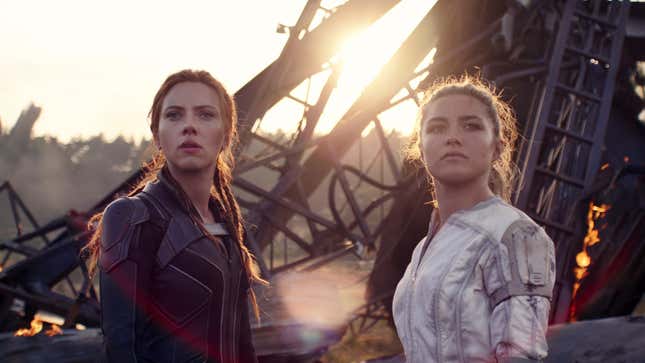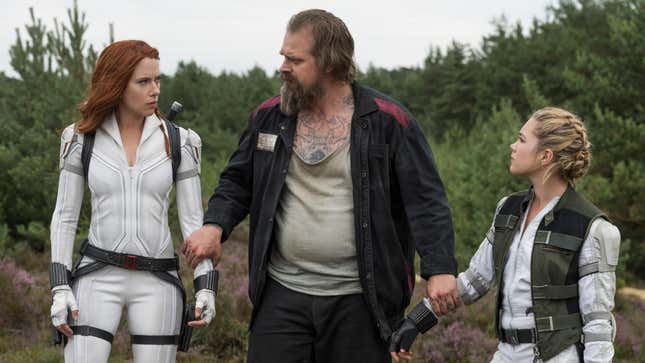
Spoiler Space offers thoughts on, and a place to discuss, the plot points we can’t disclose in our official reviews. Fair warning: This piece concerns the ending and post-credits stinger of Black Widow.
Like almost every movie in the Marvel Cinematic Universe, Black Widow features a post-credits scene, and this one carries some real emotional weight. The film proper ends with Natasha Romanoff (Scarlett Johansson), a.k.a. Black Widow, having successfully reunited her fake Russian family, then setting out to do the same for her chosen family of costumed Avengers, half of whom are still languishing in prison. (This is, after all, technically a prequel, set after the events of Captain America: Civil War.) But as every MCU fans know, the story never ends with the end credits. After they roll, we get one final scene: fellow Widow Yelena (Florence Pugh), standing somberly before her sort-of sister Natasha’s grave. “Oh right,” the viewer remembers, as we’re jumped forward to the MCU’s current, post-Endgame reality. “She’s dead.” It’s a cheap button to push, but an undeniably effective one, too.
Quickly, however, the somberness of the scene is punctured by some snarky wit, delivered by a voice behind Yelena. It comes from Contessa Valentina Allegra de Fontaine, played with relish by ace comic actor Julia Louis-Dreyfus. Yelena, it seems, is now working for this ethically ambiguous character, and her boss has interrupted some personal time at her adopted big sister’s grave with a new mission: take down Clint Barton, a.k.a. Hawkeye, the person Valentina claims is responsible for Natasha’s death.
We learn nothing more about Valentina in this scene. She shows up like Tony Stark at the end of The Incredible Hulk, like a character who requires little introduction because we’ve met her before. And audiences have met her: She first appeared back in April, in the fifth episode of Disney+’s The Falcon And The Winter Soldier. But the brusqueness of her reveal here isn’t really due to an assumed familiarity with the character, because the scene in Black Widow was originally intended to be her big introduction, back before COVID scuttled plans to release the movie in May of 2020. That Valentina’s appearance didn’t need to be tweaked is a good demonstration of how rearrangeable this supposedly precisely sequenced series of films and TV shows actually is.

It can often seem to the casual fan that Marvel makes certain that every aspect of their interconnected cinematic universe is meticulously set up years in advance. The best example of such planning is probably the post-credits introduction of Thanos at the end of the first Avengers. The giant villain was a character who wouldn’t show up again until a brief cameo in Guardians Of The Galaxy two years later, and he wouldn’t really appear in any substantial, fleshed-out way until Avengers: Infinity War, nearly four years after that. Teasing the big bad so far in advance sure suggests a well-structured plan.
But if you look at Thanos’ appearances, it becomes clear that Marvel builds some leeway for itself into the supposedly grand design of its super franchise. His first cameo reveals nothing about what might subsequently happen; Marvel could’ve gone anywhere with the character. It wasn’t until the end of Age Of Ultron that the studio definitively revealed that the bad guy would be going after all the Infinity Stones—and even then, nothing was given away about how that might happen. It was merely a confirmation that the scripting for the next Avengers film was in the planning stages. Most of the subsequent Marvel films had nothing to do with any of the impending Thanos of it all: Ant-Man, Captain America: Civil War, Doctor Strange, and more could all easily have swapped release dates with little to no effect on the overarching MCU narrative. True, not all the films can be rearranged like photos in a family album—Captain Marvel’s appearance in Endgame wouldn’t have worked at all had her solo movie not come out first. But sometimes, it’s only the teaser at the end that situates the solo Marvel movies within the larger Avengers narrative.
Just look at Black Widow and The Falcon And The Winter Soldier, and how swapping their order of release affected the post-credits scenes without affecting the larger story. Had Valentina originally made her (much more abbreviated) debut in Black Widow, all it would have done is stoke interest in a new character, posing questions that would be partially answered by The Falcon And The Winter Soldier, as well as set up a story the studio had already committed to: the upcoming Disney+ series Hawkeye. Conversely, there’s well-founded speculation that, had the two stories been released as originally planned, TFATWS’s own post-credits scene would have played out rather differently. Instead of simply confirming what we already knew—that Emily Van Camp’s Sharon Carter is the Power Broker, and she’s now embedded into S.H.I.E.L.D. in a way that her Machiavellian schemer will be able to exploit—we would’ve seen who is on the other end of Sharon’s phone call, and it would have set up a major new villain of Phase 4. (You can read the leaked speculation yourself if you’re curious—it’s from an anonymous but reliable source who has been accurate about upcoming post-credits scenes in the past.)
But here’s the thing: While changing the order of release may have affected the content of one of those post-credits “tune in next time!” teases, it likely didn’t alter the trajectory of the franchise in any way. The stingers really are just teasers; by design, they give away almost nothing.

That’s why Valentina can appear in Black Widow supposedly exactly as planned: The main purpose of the scene isn’t her introduction but to stoke curiosity and speculation about what’s next in the MCU. Valentina’s Nick Fury-like appearances thus far—recruiting failed Captain America replacement John Walker (Wyatt Russell) to be U.S. Agent, and now dropping in to give assignments to her other recruit, Yelena—imply she’s building a super-team of her own, only made up of the less overtly noble and more morally shaded characters. In the comics, they’re called the Thunderbolts, and they include such characters as Taskmaster, a.k.a. the masked killer from Black Widow revealed to be the daughter of the Red Room architect, Dreykov. This would also provide a continuing role for current antihero Baron Zemo (Daniel Brühl), who has led the Thunderbolts at various points in their history.
It would track, too, with Valentina’s comic-book origins, where she’s had several reversals of fortune and identity, going from secret agent to Russian sleeper agent to love interest for Nick Fury. Making her responsible for bringing together the Thunderbolts would allow Marvel to really get its money’s worth; the company has made no secret of its desire to put Louis-Dreyfus to work, now that her role in the MCU has been revealed. By slowly building a team of ambiguously good heroes led by a potentially sinister schemer like the Contessa, the studio can stock up on potential spin-off characters for years, while creating an Avengers-rivaling force that could provide material well beyond Phase 4. And, as the latest post-credits stinger reminds us, all of those plans could turn on a dime, and it wouldn’t matter in the slightest to an audience eager for promises of further adventures—for the tiniest scraps of foreshadowing, devoid of any hints of how those adventures will actually play out.